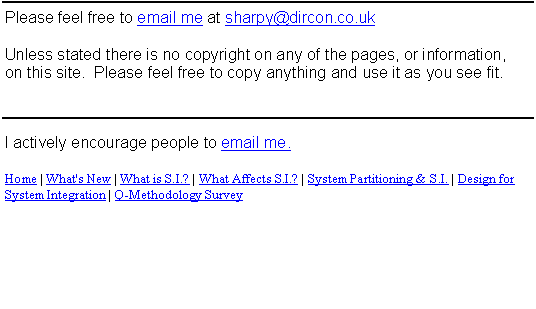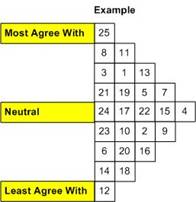
|
System Integration |
|
Dedicated to the dissemination of System Integration information |

|
About Q-Methodology |
|
The Q-Methodology is a survey methodology orientated towards the social sciences and subjectivity. Participants are asked to rank a series of statements into a ‘quasi-normal’ grid. |


|
|

|
In the above example the participant was provided with 25 statements that could describe their car, e.g. it is reliable, It is cheap to run, I see it as a ‘fashion accessory’, it reflects my personality etc. They were then asked to put the statement numbers into the grid depending on how much they agreed with the statements. The above grid was one participants answers. You can then feed the answer grid into series of mathematical algorithms that produce a set of values depending on the answer grid. From these values you can see how people think about their car, what they see it as, what is their view on their car etc. It is also possible to group like minded individuals. It could be the case that women who are aged between 20 and 29 see the car as a fashion accessory, all men see their car as reflecting their personality etc. The most obvious question is why are participants asked to arrange the answers into a grid? If you had a normal survey where respondents can assign an importance to each answer they could see every factor as important and give the same answer for each statement. Whilst this is a valid set of responses it provides less information about how they think, what their personality is. It doesn’t force them to think ‘relatively’, to differentiate between factors. If respondents could rank all answers the same some would, some would also group large numbers of answers. The survey I am carrying out is to do with defence system functional partitioning and the subsequent System Integration (S.I.). Why am I using the Q-Methodology? The first answer is that the Q-Methodology has academic justification to be used in this context. If the Software Engineering Institute at Carnegie Mellon University say it can be used to investigate S.I. that will do for me! It was also the case that, in informal interviews with system architects and S.I. about what affects their efficiency everyone mentioned ‘non-technical’ factors, e.g. lack of communication, company politics etc. I needed a survey methodology that was suited to social factors, subjectivity; the Q-Methodology fits the bill. Once I had decided on the Q-Methodology I then looked at the process. Freeware is available for the analysis of the data. This was a big help. A case of the ‘non-technical’ affecting the process! The next question was how to administer the survey. I looked at online Q-Methodology software but user testing showed some confusion when people were asked to fill the form out. I decided to create my own form. I used MS Excel to create the form; the image above is a snap shot from the Excel file. Right click on the previous link and select ‘Save Target As’ to download and view the file. The file is the car example I speak of above, the purpose of the survey was user testing of the form. I will ask people to fill out the Excel File and Email it back to me. I also created some paper survey forms for people who prefer that way of filling out the forms. The Q-Methodology survey is crucial to my dissertation so I need to offer people as many means as possible of filling out the survey. |